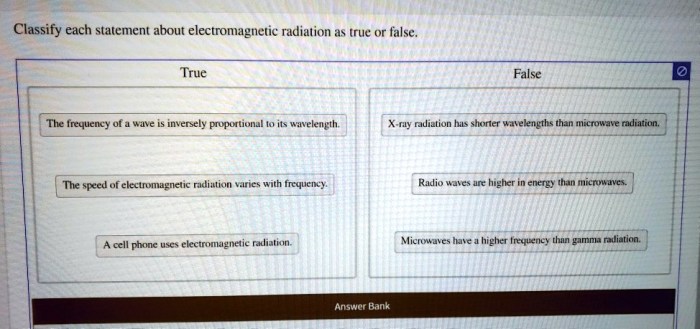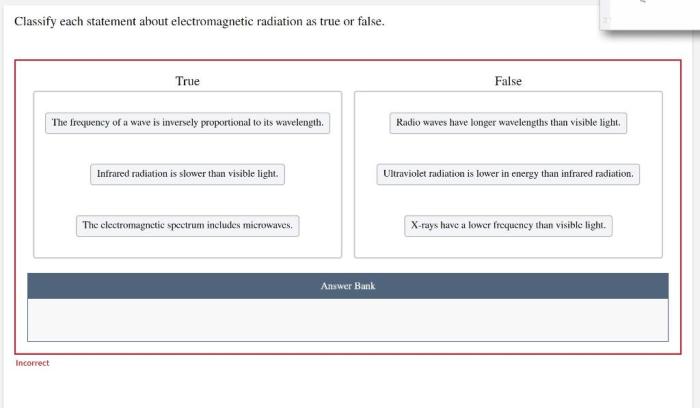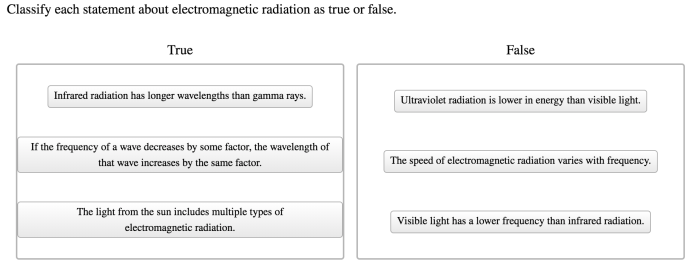Classify each statement about electromagnetic radiation as true or false – Embarking on an exploration of electromagnetic radiation, this discourse delves into the realm of truth and falsehood, unraveling the complexities of this enigmatic phenomenon. We embark on a journey to categorize a comprehensive array of statements, discerning their veracity and dispelling misconceptions.
Electromagnetic radiation, a captivating enigma, permeates our world, manifesting in diverse forms, from the gentle caress of radio waves to the penetrating power of gamma rays. Understanding its properties and behavior empowers us to harness its potential while mitigating potential risks.
Electromagnetic Radiation
Electromagnetic radiation (EMR) is a form of energy that travels through space in the form of waves. It is made up of electric and magnetic fields that oscillate perpendicular to each other. EMR is a fundamental part of our universe and plays a vital role in many natural phenomena, including light, heat, and radio waves.EMR
can be classified into different types based on its wavelength or frequency. The electromagnetic spectrum, which organizes EMR by its wavelength, includes radio waves, microwaves, infrared radiation, visible light, ultraviolet radiation, X-rays, and gamma rays. Each type of EMR has its own unique properties and applications.
Properties of Electromagnetic Radiation

EMR exhibits both wave-like and particle-like properties, a phenomenon known as wave-particle duality. As a wave, EMR can be characterized by its wavelength, frequency, and amplitude. The wavelength is the distance between two consecutive crests or troughs of the wave, while the frequency is the number of waves that pass a given point in one second.
The amplitude is the maximum displacement of the wave from its equilibrium position.As a particle, EMR can be described as a photon. A photon is a quantum of energy that has no mass or charge. The energy of a photon is proportional to its frequency.
The higher the frequency of the photon, the higher its energy.
Spectrum of Electromagnetic Radiation
The electromagnetic spectrum is a continuous range of wavelengths or frequencies of EMR. It can be divided into several regions, each with its own unique properties and applications:
- Radio waves: Radio waves have the longest wavelengths and lowest frequencies in the electromagnetic spectrum. They are used for communication, navigation, and remote sensing.
- Microwaves: Microwaves have shorter wavelengths and higher frequencies than radio waves. They are used for cooking, heating, and communication.
- Infrared radiation: Infrared radiation has even shorter wavelengths and higher frequencies than microwaves. It is used for thermal imaging, remote sensing, and heating.
- Visible light: Visible light is the only type of EMR that can be seen by the human eye. It is used for communication, illumination, and photography.
- Ultraviolet radiation: Ultraviolet radiation has shorter wavelengths and higher frequencies than visible light. It is used for sterilization, tanning, and medical imaging.
- X-rays: X-rays have even shorter wavelengths and higher frequencies than ultraviolet radiation. They are used for medical imaging, security screening, and crystallography.
- Gamma rays: Gamma rays have the shortest wavelengths and highest frequencies in the electromagnetic spectrum. They are used for cancer treatment, medical imaging, and nuclear physics.
Generation and Detection of Electromagnetic Radiation
EMR can be generated in a variety of ways, including thermal emission, particle acceleration, and nuclear transitions. Thermal emission is the process by which objects emit EMR due to their temperature. Particle acceleration is the process by which charged particles are accelerated, causing them to emit EMR.
Nuclear transitions are the processes by which atoms or nuclei change energy levels, causing them to emit or absorb EMR.EMR can be detected using a variety of methods, including antennas, photodiodes, and spectrometers. Antennas are used to detect radio waves and microwaves.
Photodiodes are used to detect visible light and ultraviolet radiation. Spectrometers are used to detect EMR across a wide range of wavelengths.
Applications of Electromagnetic Radiation

EMR has a wide range of applications in various fields, including communication, medicine, imaging, and scientific research.
- Communication: EMR is used for communication over long distances. Radio waves are used for radio and television broadcasting. Microwaves are used for cellular phones and satellite communication. Infrared radiation is used for fiber optic communication.
- Medicine: EMR is used for a variety of medical applications, including medical imaging, cancer treatment, and surgery. X-rays are used for medical imaging. Gamma rays are used for cancer treatment. Infrared radiation is used for surgery.
- Imaging: EMR is used for a variety of imaging applications, including photography, remote sensing, and thermal imaging. Visible light is used for photography. Infrared radiation is used for remote sensing. Microwaves are used for thermal imaging.
- Scientific research: EMR is used for a variety of scientific research applications, including astronomy, particle physics, and nuclear physics. Radio waves are used for astronomy. X-rays are used for particle physics. Gamma rays are used for nuclear physics.
Safety Considerations: Classify Each Statement About Electromagnetic Radiation As True Or False

EMR can be harmful to human health if it is not used properly. Exposure to high levels of EMR can cause skin burns, eye damage, and cancer. It is important to follow safety guidelines when using EMR-emitting devices.The International Commission on Non-Ionizing Radiation Protection (ICNIRP) has established guidelines for safe exposure to EMR.
These guidelines are based on the scientific evidence of the health effects of EMR. It is important to follow these guidelines to minimize the risk of exposure to harmful levels of EMR.
FAQ Overview
Is visible light a type of electromagnetic radiation?
True
Are gamma rays more energetic than X-rays?
True
Can electromagnetic radiation travel through a vacuum?
True